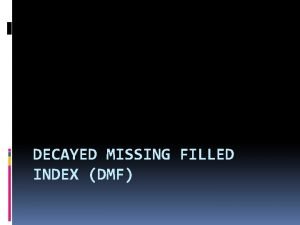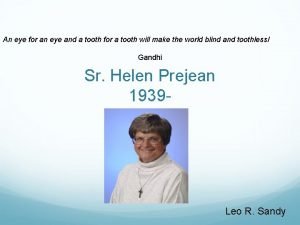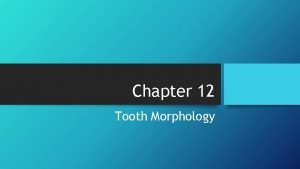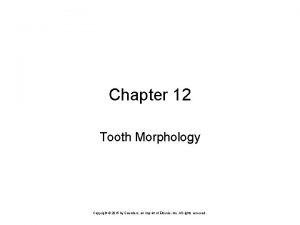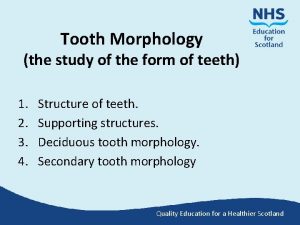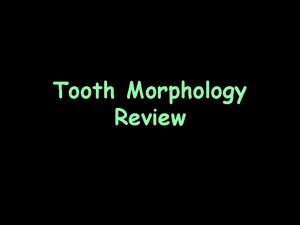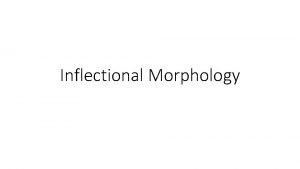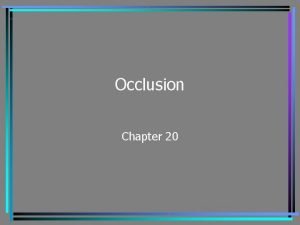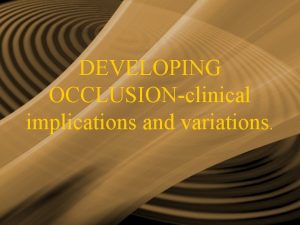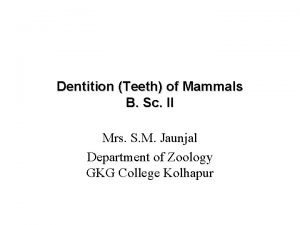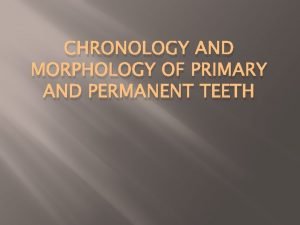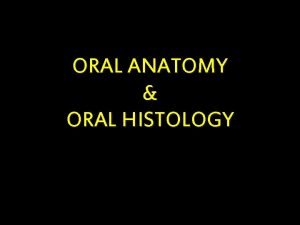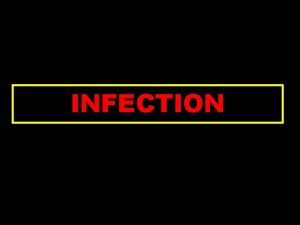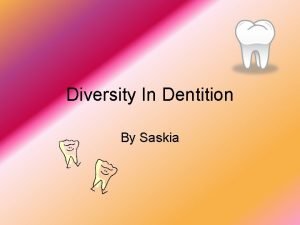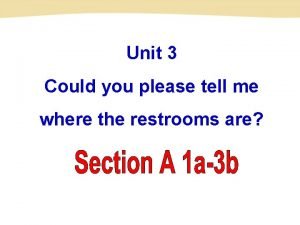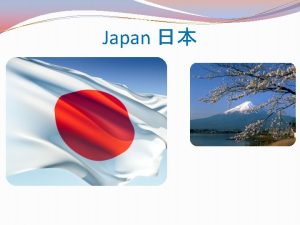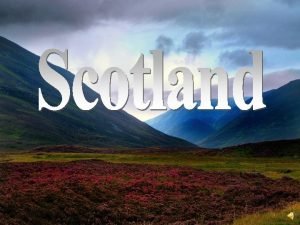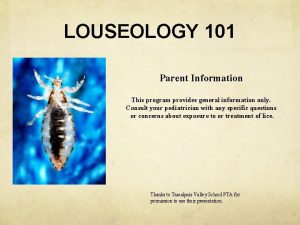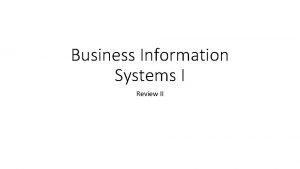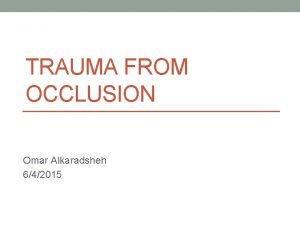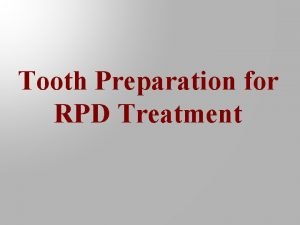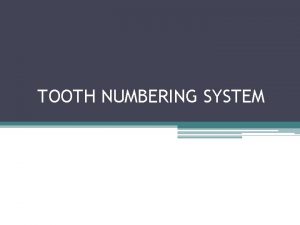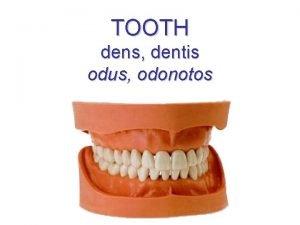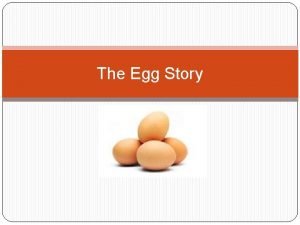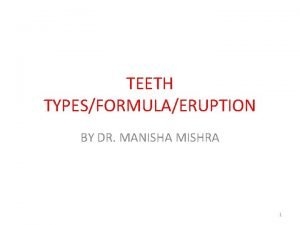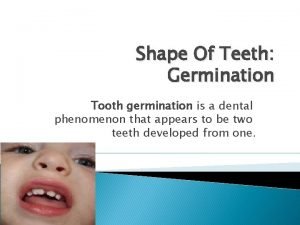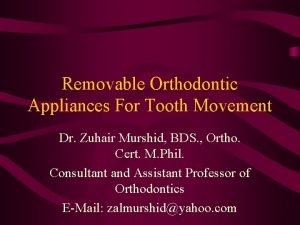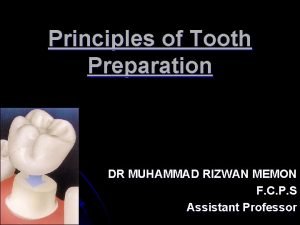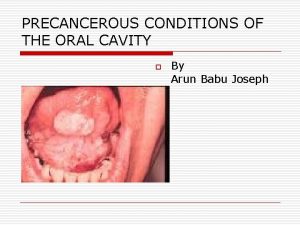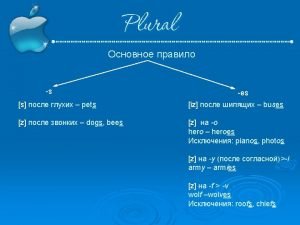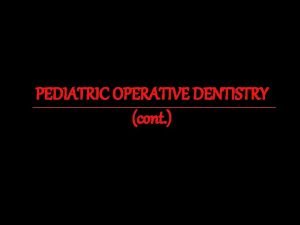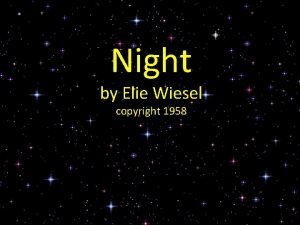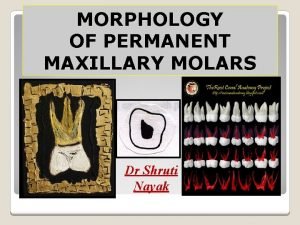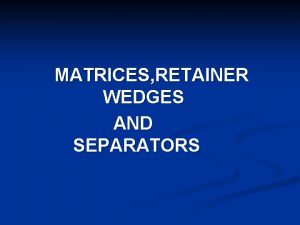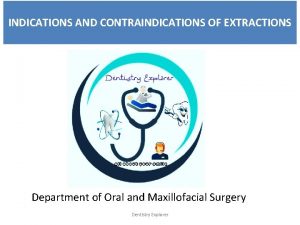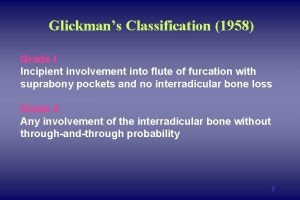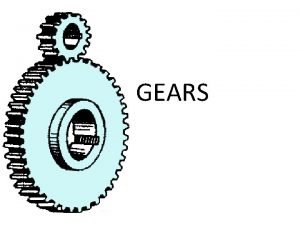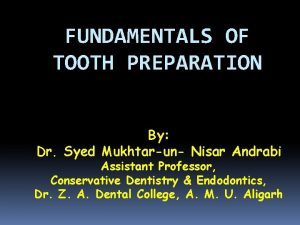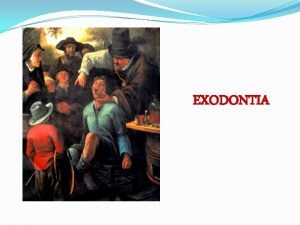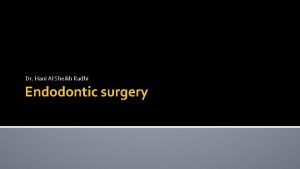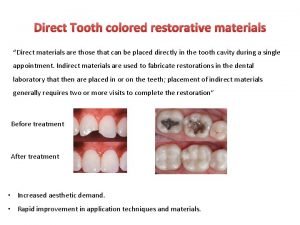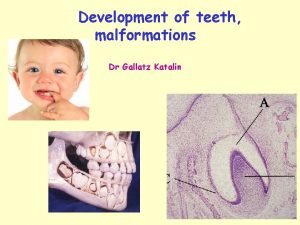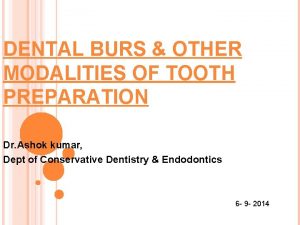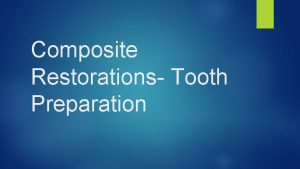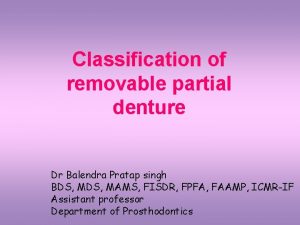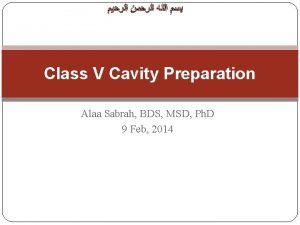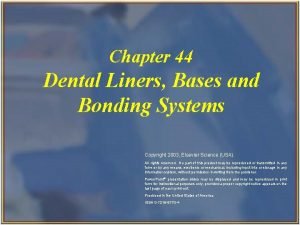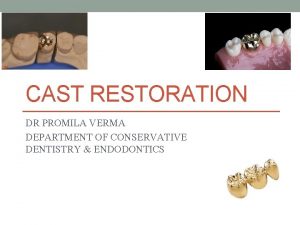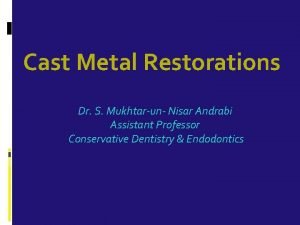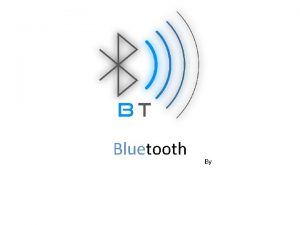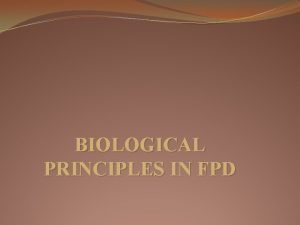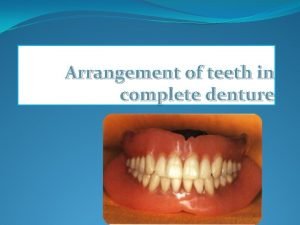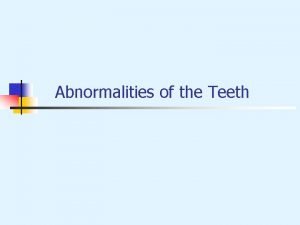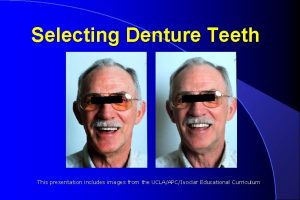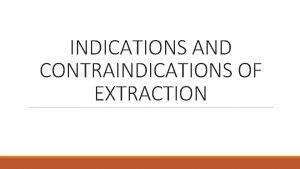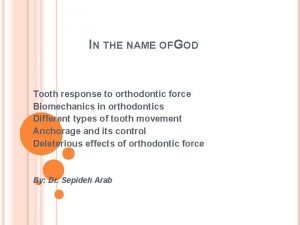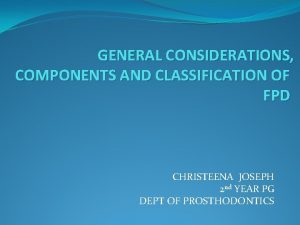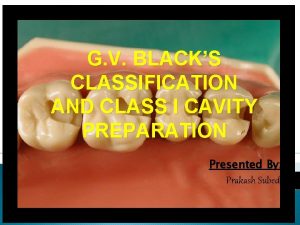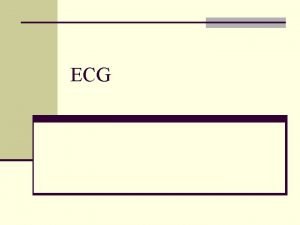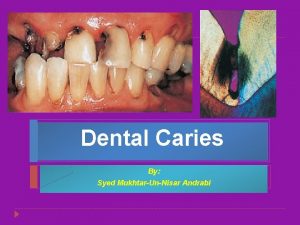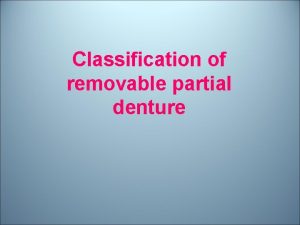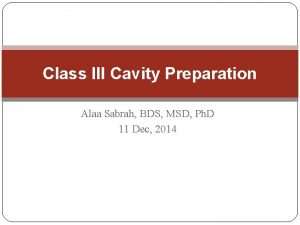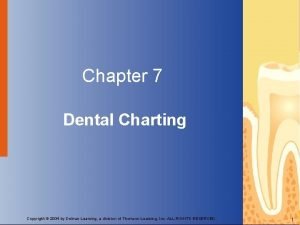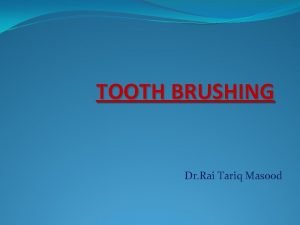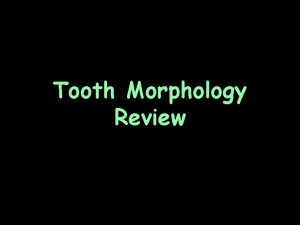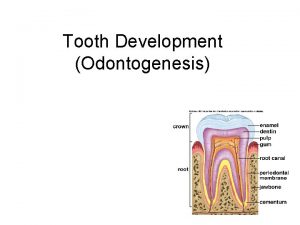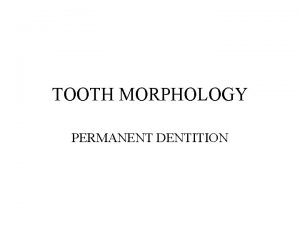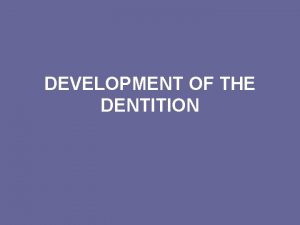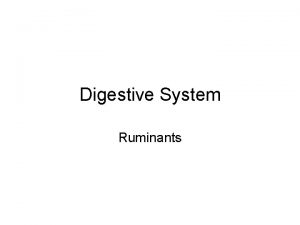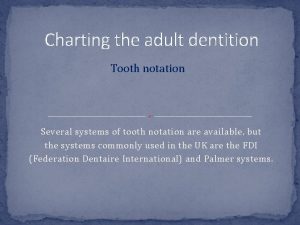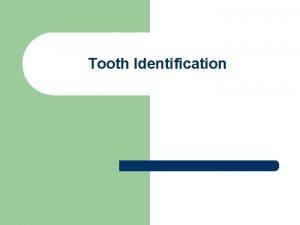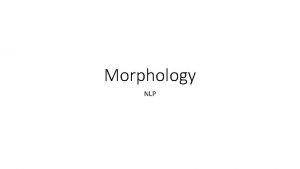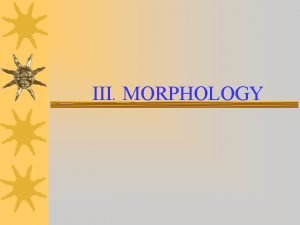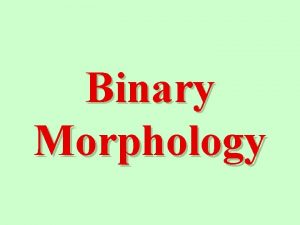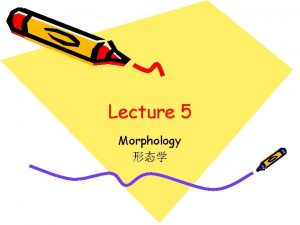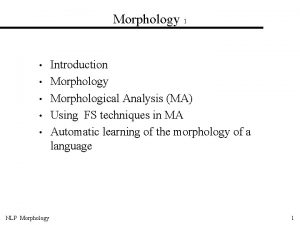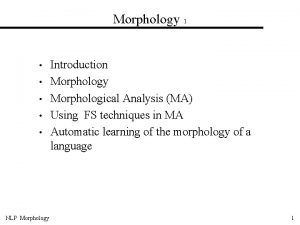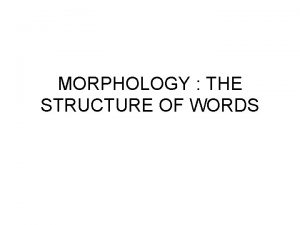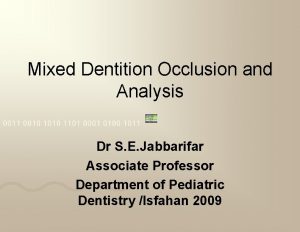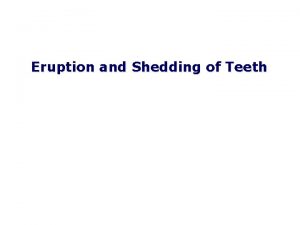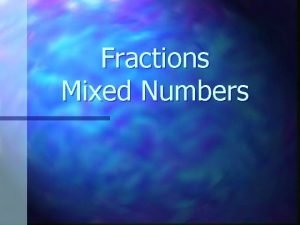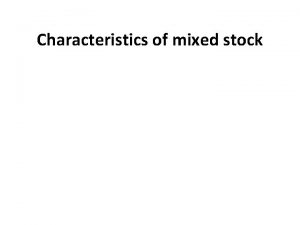Tooth Morphology Review Some general information Mixed dentition




























































































- Slides: 92

Tooth Morphology Review

Some general information. . .

Mixed dentition: mix of deciduous and permanent, 6 - 12 yrs

Succedaneous teeth: permanent teeth that replace deciduous • Permanent molars are the only teeth not succedaneous • Premolars succeed primary molars – Only succedaneous teeth not having the same name as their primary counterparts

Normal eruption sequence (permanent teeth) • Mandibular teeth precede maxillary counterparts • Mandibular teeth erupt in anterior to posterior order • Maxillary arch: maxillary canine erupts after premolars (last succedaneous tooth to erupt)

Permanent Eruption Sequence • 1. Mandibular first molar: 6 - 7 yrs • 2. Maxillary first molar: 6 - 7 yrs • • 3. 4. 5. 6. Mandibular central incisor: 6 - 7 yrs Mandibular lateral incisor: 7 - 8 yrs Maxillary central incisor: 7 - 8 yrs Maxillary lateral incisor: 8 - 9 yrs

• • • 7. Mandibular canine: 9 - 10 yrs 8. Mandibular first premolar: 10 - 11 yrs 9. Maxillary first premolar: 10 - 11 yrs 10. Mandibular second premolar: 11 - 12 yrs 11. Maxillary second premolar: 11 - 12 yrs 12. Maxillary canine: 11 - 12 yrs • • 13. 14. 15. 16. Mandibular second molar: 11 - 13 yrs Maxillary second molar: 12 - 13 yrs Mandibular third molar: 17 - 21 yrs Maxillary third molar: 17 - 21 yrs

Notes: • Mandibular central is first succedaneous tooth to erupt • Maxillary canine is last succedaneous tooth to erupt • Premolars are the only succedaneous teeth having a different name than their deciduous counterpart • Root completion is generally 2 - 3 yrs after eruption

Know the following terms: • • Cusps Tubercles (mini cusps) Cingulum Ridges – – – Marginal ridges Triangular ridges Transverse ridges Oblique ridge Cusp ridges Incline planes

• • Mammelons Fossa Developmental groove Supplemental groove Pit Contact area Developmental lobe

Lobes: • All anterior teeth have 4 lobes – 3 labial – 1 lingual • Premolars: – 3 lobes for facial cusp – 1 or 2 lobes for lingual cusp(s) • Lobes of molar teeth correspond to the number of major cusps

Crown surface geometric outline forms: • Triangular • Trapezoidal • Rhomboidal

Facial and Lingual surfaces: • All have trapezoidal geometric form

Mesial and Distal surfaces: • Anteriors: triangular • Maxillary posteriors: trapezoidal • Mandibular posteriors: rhomboidal

Contact areas: • • • Central incisors: mesial contacts mesial Aids in stabilizing arch form Prevention of food impaction Aids food flow pattern Become larger over time

Notes: • Contacts become more cervical from anterior to posterior • Distal contact usually more cervical than mesial (exception: mandibular 1 st premolars & mandibular centrals) • Anterior contacts centered (F-L) • Posterior contacts are facial to center (F-L)

Embrasures: • Incisal (occlusal) embrasures increase in size from anterior to posterior • Cervical (gingival) embrasures decrease in size from anterior to posterior • Labial and lingual embrasures nearly equal in anteriors • Lingual embrasures larger than labials in posteriors

Facial and lingual heights of contour: • Facially: cervical third for ALL teeth • Lingually: – Anteriors: cervical third – Posteriors: middle third (exception: occlusal third for mand 2 nd premolar)

Curvature of CE line: • Curvature usually greater on mesial than distal • Curvatures become flatter from anterior to posterior

Important Characteristics of Tooth Types

Maxillary Central Incisor • Crown is almost as wide as it is long – Only incisor where MD = IC (almost) • Contact area – Mesial: incisal third – Distal: near junction of incisal and middle third

• Mesial CEJ has greatest depth of curvature of any tooth • Facial CEJ flatter curvature than other anteriors • Incisal view roughly triangular

Notes: (max central) • 1. M-D widest of all anteriors • 2. M-D nearly as wide as I-C • 3. M-D is wider than F-L (other anteriors are wider F-L than M-D, except maxillary lateral ) • 4. Cross-section at cervical is triangular

Maxillary Lateral Incisor: • Smaller, more rounded than central • Root length almost as long • Greater variation in form (except 3 rd molars) • Sometimes missing congenitally

Maxillary Lateral… • Incisally more rounded than other incisors • Lingual-gingival groove and lingual pit common • Contact area – Mesial: incisal 1/3 near junction of incisal and middle third – Distal: junction of incisal and middle third (most cervical of the incisors)

Notes: (max lateral) • 1. Incisal edge contour is more rounded than any other incisor • 2. Most likely to have lingual pit of all incisors • 3. Lingual fossa and marginal ridges more prominent than other incisors • 4. DI corner most rounded of all incisal corner • 5. MD close to FL dimension (MD>FL)

Mandibular Incisors: • Simplest, least variable teeth • Proximal view: Incisal edge is lingual to long axis of tooth • Lateral has distal twist to crown • Contact areas: – Mesial and distal: incisal third • Bifurcated root sometimes found

Notes: (mand incisors) • Mandibular Central Incisor – Bilaterally most symmetrical – M and D contact areas both at same level in incisal third – Root shortest of anterior teeth – One wear facet on incisal edge • Mandibular Lateral Incisor – DI corner visible from mesial view – Distal contact area more lingual than mesial contact area

Maxillary Canine: • • Crown + root length = longest tooth Last succedaneous tooth to erupt Facial/lingual view: pentagonal (5 -sided) Contact areas: – Mesial: junction of incisal and middle third – Distal: middle third (most cervical of the anteriors)

• Proximal view: cusp tip is just facial to mid-line of root • MI cusp ridge shorter than DI • Presence of labial and lingual ridges • Cingulum more pronounced than mandibular • Single root is longest of any tooth

Notes: (max canine) • 1. Crown length nearly as long as maxillary central’s • 2. Two lingual fossae - ML and DL separated by lingual ridge • 3. Root is longest of all teeth • 4. Largest F-L of anteriors

Mandibular Canine: • • Narrower MD than maxillary Mesial outline is straight line MI cusp ridge shorter than DI Cusp tip located lingual to proximal long axis • Bifurcated root sometimes found • Contact areas: – Mesial: incisal third – Distal: junction of incisal and middle third

Notes: (mand canine) • 1. Crown longer than maxillary canine (longest crown in the mouth) • 2. Longest root in mandibular arch • 3. Total length almost the same as maxillary canine • 4. M and D height of contours more incisal than maxillary canine • 5. Facial outline “moon-shape”

Maxillary Premolars: • Crowns are wider FL than MD • 2 cusps, nearly equal size • 1 st is little larger than 2 nd

Maxillary 1 st Premolar: • Occlusal outline is hexagonal • Facial outline is pentagonal • Contact areas: – Mesial: junction of occlusal and middle third; mesial marginal groove – Distal: more cervically and facially located than mesial • MF cusp ridge is longer than DF – Facial cusp tip offset to distal – Lingual cusp tip offset to mesial facial to

• Lingual cusp of 1 st is shortest of maxillary premolars • Pronounced mesial concavity • Pronounced mesial marginal groove • More angular than 2 nd • M and D pits further apart - longer central groove • Less secondary grooves than 2 nd

Root structure of max 1 st premolar: • Type I - single root with 2 pulp canals – Cross section is kidney shaped, mesial indented • Type II - bifurcated root with root trunk (most common) • Type III - laminated root – Cross section is hour-glass • Trifurcated roots sometimes found: 2 buccal, 1 lingual

Notes: (max 1 st premolar) • 1. MB cusp ridge longer than DB cusp ridge (similar to primary max canine) • 2. Buccal cusp tip located distal to tooth midline • 3. Lingual cusp shortest of maxillary premolar cusps, tipped mesially • 4. Strong mesial crown/root concavity

• 5. Mesial marginal ridge shorter than distal marginal ridge • 6. Cervical cross-section is kidney shape • 7. Two canals (F and L) – lingual has larger pulp canal – facial pulp canal is longer (facial cusp taller)

Maxillary 2 nd Premolar: • • • Smaller in all dimensions than 1 st More rounded crown form F and L cusps nearly equal in height Lingual cusp tip offset mesially No mesial concavity

• More rounded than 1 st • M and D pits closer - shorter central groove • More supplemental grooves • Normally single root, bifurcation possible

Notes: (max 2 nd premolar) • 1. F and L cusps more equal • 2. M and D halves more symmetrical than other premolars • 3. Distal root surface has deeper depression

Mandibular Premolars: • • • 1 st is smaller than 2 nd FL and MD dimensions about equal F cusp more prominent than L Crown profile tilts towards lingual Normally single rooted, bifurcation possible

Mandibular 1 st Premolar: • Looks and functions more like canine – Lingual cusp non-functional • M and D height of contour in middle third (distal possibly more occlusal*) • Lingual cusp tip offset to mesial • Presence of ML developmental groove

• Occlusal view: rounded diamond shape • Distal fossa circular, mesial fossa linear • Mesial marginal ridge slopes at 45 o, distal ridge is horizontal • Single root, bifurcation possible (F and L roots)

Notes: (mand 1 st premolar) • 1. Both M and D height of contours at middle third (with distal possibly even more occlusal) • 2. Only premolar with a ML groove • 3. Proximal view - buccal cusp tip centered over root midline (unique of all premolars) • 4. Pronounced transverse ridge separating M and D fossae

• 5. Mesial marginal ridge inclined more than other premolar marginal ridges, more cervical than distal marginal ridge • 6. Buccal cusp occupies more of the occlusal surface than other premolars

Mandibular 2 nd Premolar: • Larger than 1 st mand premolar • 2 forms: 2 cusps and 3 cusps – Y type groove (3 cusps) most common • 3 pits: M, D, and central • Lingual groove present • No transverse ridge – U and H type grooves (2 cusps) • 2 pits, M and D • Transverse ridge present

• Resembles small molar: marginal ridges horizontal • Lingual height of contour at occlusal third (unique) • Single root, bifurcation possible (F and L) • Sometimes congenitally missing

Notes: (mand 2 nd premolar) • 1. Buccal cusp ridges less steeply inclined than other premolars • 2. Lingual height of contour at occlusal third (unique) • 3. Three occlusal patterns: Y, U, H

• 4. Y-shape type: – – – 3 cusps 5 developmental lobes Possible lingual groove 3 pits, 3 fossae (M, C, D) No true transverse ridge Lingual M-D width possibly wider than facial width*

• 5. Two-cusp pattern: (U and H shape) – – – 4 developmental lobes Lingual cusp tipped mesially No lingual groove 2 pits, 2 fossae Transverse ridge present More lingual taper than 3 -cusp type

Permanent Molars: • 1 st molars are cornerstones in development of occlusion • Crowns are largest and most complex • 3 - 5 cusps • Multi-rooted

Maxillary Molars: • • Crowns wider FL than MD Oblique ridge and DL groove unique 3 roots: lingual, MB and DB 4 cusps: ML, MB, DL

Maxillary 1 st Molar: • Largest tooth in maxillary arch • Shorter O-C than premolars • Contact areas: – Mesial: junction of occlusal and middle third – Distal: middle third • Distal cervical crown/root concavity • MB root oftentimes has 2 canals; apex inline with MB cusp tip

• • ML cusp largest Cusp of Carabelli Distal view: all 4 Mesial view: only (ML>MB>DB>DL) on ML cusps visible 2 cusps visible

• Occlusal view: rhomboidal form – MB and DL corners acute angle – DB and ML corners obtuse • Wider MD on lingual than buccal • V-shape CE dip toward bifurcation on facial surface

Notes: (max 1 st molar) • 1. Largest tooth in maxillary arch • 2. Largest crown in mouth, largest F-L dimension of any tooth • 3. Least variable in anatomic form • 4. Presence of a facial bucco-gingival ridge running mesiodistally • 5. Lingual width possibly wider than facial width

• 6. Pronounced distal cervical concavity • 7. Oblique ridge about same height as marginal ridges • 8. Three pits and four fossae • 9. Palatal (lingual) root wider M-D than F-L • 10. MB root might have 2 pulp canals: MB and ML canals

Maxillary 2 nd Molar: • Smaller than 1 st, esp. M-D • 2 crown forms: – Rhomboidal (like 1 st) – Heart-shaped (smaller DL cusp)

Notes: (max 2 nd molar) • 1. Two crown forms: rhomboidal and heart-shape (diminished DL cusp) • 2. MB root apex is inline with buccal groove

Maxillary 3 rd Molar: • Smallest molar in mouth • Most variation in crown and root form of any maxillary tooth • Most often congenitally missing

Notes: (max 3 rd molar) • 1. Most variable anatomic form of all teeth • 2. Shortest O-C crown of any tooth • 3. Shortest roots of any tooth

Brain overload… …all the best tomorrow!

Mandibular Molars: • MD wider than FL • Rectangular occlusal outline • 4 - 5 cusps – 2 lingual cusps same size

Mandibular 1 st Molar: • • 1 st permanent tooth to erupt Largest tooth of mandibular arch 5 cusps: MB>ML>DL>DB>D Contact areas: – Mesial: junction of occlusal and middle third – Distal: junction of occlusal and middle third

• CE sometimes dips towards bifurcation on facial • No transverse ridges(? ) • 3 fossae: central, mesial, distal • 2 roots: mesial larger than distal – Mesial has 2 root canals (MB & ML) • 3 roots sometimes: MB, ML, D

Notes: (mand 1 st molar) • 1. Facial surface is largest surface of any tooth • 2. CE line more occlusal on lingual than buccal i. e. root length is longer on lingual than buccal • 3. Mesial root has 2 pulp canals: MB & ML

• 4. Distal surface of M root and mesial surface of D root have deeper root depressions (inner surfaces of both roots) • 5. May exhibit 3 roots: – 2 mesial (MB, ML) roots – 1 distal root

Mandibular 2 nd Molar: • • • 4 cusps: MB largest Occlusal anatomy simplest of any molar Most symmetrical of molars 2 transverse ridges Root form similar to 1 st

Mandibular 3 rd Molar: • Variable in size and shape: • Type I: crown similar to 2 nd molar • Type II: crown similar to 1 st molar (5 cusps) • Often congenitally missing

Pulp morphology: • Functions of pulp: – – Formation of dentin Nutrition Sensation Defense and protection (reparative dentin)

Some things to remember: • Outline of pulp cavity follows external contour of tooth • Roots with round cross section possess one canal • Roots with oval or elongated cross section often more than one canal

• Lateral (accessory) canals: lateral canals found in the apical third • Supplementary canal: canal in excess of normal number of canals • Anastomosis: canal branch that connects horizontally between canals

• Know anatomical root forms of each tooth type, esp. in cross-section – Comparative widths (M-D vs F-L) – Shapes (e. g. oval, round, triangular, etc) – Number of pulp canals

Maxillary Central Incisor: • Newly erupted central has 3 pulp horns • Pulp chamber wider MD than FL • Cervical cross section, pulp outline triangular

Maxillary Canine: • Pulp cavity wider FL than MD (oval) • Root canal longest in mouth

Maxillary 1 st Premolar: • • • Wider FL than MD 2 roots (F and L), 2 canals Buccal pulp horn larger (larger F cusp) Lingual pulp canal larger diameter Cervical cross section is kidney shape

Maxillary 1 st Premolar

Maxillary 1 st Molar: • 3 roots, 3 - 4 canals • MB often has 2 canals (70%) • Lingual root/canal largest wider ML than FL

Mandibular Canine: • Sometimes has two roots and two canals (F and L)

Mandibular 1 st Premolar: • 1 -2 pulp horns, larger buccal, smaller/diminished lingual • 2 roots and 2 canals possible (F and L)

Mandibular 1 st Molar: • 2 roots, mesial (larger) and distal • 3 canals (70%) MB, ML, and D

Deciduous Dentition Some unique features. . .

Maxillary Central (primary) • 1. No mamelons • 2. M-D crown width greater than I-C width (only anterior tooth, primary or permanent, with this characteristic)

Maxillary Canine (primary) • 1. M & D contacts at same level • 2. M-D and I-C dimensions similar • 3. Mesial cusp ridge longer than D cusp ridge (similar to max 1 st premolar)

Maxillary 1 st Molar (primary) • 1. Crown does not resemble any other molar - appears more like a premolar • 2. Facial CE line dips prominently towards mesial • 3. No root trunk

Maxillary 2 nd Molar (primary) • 1. Larger than primary 1 st max molar • 2. Most closely resembles permanent 1 st maxillary molar • 3. Presence of Carabelli cusp • 4. No root trunk

Mandibular 1 st Molar (primary) • 1. Crown unlike any other tooth, primary or permanent • 2. Facial CE line dips prominently towards mesial • 3. Facial cervical ridge has strong mesial bulge

• 4. Pronounced mesial transverse ridge • 5. Mesial and central pits, no distal pit • 6. No root trunk

Mandibular 2 nd Molar (primary) • 1. Closely resembles permanent 1 st mandibular molar • 2. No root trunk

That’s Enough for Today!!!
 How to calculate dmft score
How to calculate dmft score An eye for an eye a tooth for a tooth sister act
An eye for an eye a tooth for a tooth sister act Smallest teeth in permanent dentition
Smallest teeth in permanent dentition Copyright
Copyright Tooth morphology definition
Tooth morphology definition Tooth morphology notes
Tooth morphology notes What is inflectional and derivational morphology
What is inflectional and derivational morphology Vertical definition
Vertical definition Predentate period
Predentate period Types of mammalian teeth
Types of mammalian teeth Dental lamina
Dental lamina Name the five lesions associated with hiv/aids chapter 17
Name the five lesions associated with hiv/aids chapter 17 Hetero dont
Hetero dont Intact dentition
Intact dentition Diastema in cows
Diastema in cows They say it only takes a little faith
They say it only takes a little faith God when you choose to leave mountains unmovable
God when you choose to leave mountains unmovable Cakecountable or uncountable
Cakecountable or uncountable What are some contact forces and some noncontact forces
What are some contact forces and some noncontact forces Some say the world will end in fire some say in ice
Some say the world will end in fire some say in ice Some say the world will end in fire some say in ice
Some say the world will end in fire some say in ice Some trust in chariots and some in horses song
Some trust in chariots and some in horses song Diferencia entre gran plano general y plano general
Diferencia entre gran plano general y plano general Where did general lee surrender to general grant?
Where did general lee surrender to general grant? Five opportunities in media and information
Five opportunities in media and information Could you tell me? where is the bookstore?
Could you tell me? where is the bookstore? Unit 6 review questions
Unit 6 review questions Chapter review motion part a vocabulary review answer key
Chapter review motion part a vocabulary review answer key Ap gov final review
Ap gov final review Narrative review vs systematic review
Narrative review vs systematic review What is inclusion and exclusion criteria
What is inclusion and exclusion criteria Narrative review vs systematic review
Narrative review vs systematic review General information about japan
General information about japan Scotland general information
Scotland general information Provides general information
Provides general information Review of business information systems
Review of business information systems Miller classification
Miller classification Shape of rest seat in rpd
Shape of rest seat in rpd Primary teeth numbering system
Primary teeth numbering system Histodifferentiation stage of tooth development
Histodifferentiation stage of tooth development Lamina dentalis
Lamina dentalis Is an egg a chicken embryo
Is an egg a chicken embryo Modified fdi system
Modified fdi system Germination tooth
Germination tooth Tooth decay science fair project graph
Tooth decay science fair project graph Removable appliance components
Removable appliance components Shoulder margin
Shoulder margin Osmf differential diagnosis
Osmf differential diagnosis Tooth teeth foot feet
Tooth teeth foot feet Feet woman
Feet woman Isthmus in cavity preparation
Isthmus in cavity preparation Night by elie wiesel citation
Night by elie wiesel citation Oblique ridge of maxillary molar
Oblique ridge of maxillary molar Ferrier tooth separator
Ferrier tooth separator Contraindications of tooth extraction
Contraindications of tooth extraction Tattletooth program
Tattletooth program Askov dental program
Askov dental program Furcation flutes
Furcation flutes Gear applications
Gear applications Class v preparation
Class v preparation Straight elevator principle
Straight elevator principle Orthograde vs retrograde root filling
Orthograde vs retrograde root filling Tooth colored restorative materials
Tooth colored restorative materials Suprabulge and infrabulge
Suprabulge and infrabulge Ectomesenchyme
Ectomesenchyme Dental burs shapes
Dental burs shapes Bevel in class 3 composite
Bevel in class 3 composite Kennedy class 1 mod 2 rpd design
Kennedy class 1 mod 2 rpd design Class v cavity
Class v cavity Bases in dentistry
Bases in dentistry Distoclusion definition
Distoclusion definition Skirt preparation in conservative dentistry
Skirt preparation in conservative dentistry Primary flare and secondary flare
Primary flare and secondary flare Safi pearl casting
Safi pearl casting Why is it called blue tooth
Why is it called blue tooth Mechanical principles of tooth preparation
Mechanical principles of tooth preparation Teeth arrangement in complete denture
Teeth arrangement in complete denture Supernumeray
Supernumeray Semi anatomic teeth degree
Semi anatomic teeth degree Contraindications of tooth extraction
Contraindications of tooth extraction Mechanical principles
Mechanical principles Cast mesh fpd
Cast mesh fpd Cavosurface margin for composite
Cavosurface margin for composite Saw tooth appearance ecg
Saw tooth appearance ecg Turbid dentin in carious tooth
Turbid dentin in carious tooth Uncountable nouns are singular or plural
Uncountable nouns are singular or plural Cummer classification
Cummer classification Class 4 cavity preparation walls
Class 4 cavity preparation walls Tooth surfaces charting
Tooth surfaces charting This tooth kill me lately
This tooth kill me lately Charters brushing method
Charters brushing method Mammoth vs saber tooth tiger
Mammoth vs saber tooth tiger Tooth number 13
Tooth number 13
